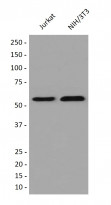ARG59280
anti-Thioredoxin Reductase 1 antibody
anti-Thioredoxin Reductase 1 antibody for Western blot and Human,Mouse
Overview
| Product Description | Rabbit Polyclonal antibody recognizes Thioredoxin Reductase 1 |
|---|---|
| Tested Reactivity | Hu, Ms |
| Tested Application | WB |
| Host | Rabbit |
| Clonality | Polyclonal |
| Isotype | IgG |
| Target Name | Thioredoxin Reductase 1 |
| Antigen Species | Human |
| Immunogen | Synthesized peptide derived from Human Thioredoxin Reductase 1. |
| Conjugation | Un-conjugated |
| Alternate Names | Thioredoxin reductase 1, cytoplasmic; EC 1.8.1.9; Gene associated with retinoic and IFN-induced mortality 12 protein; Gene associated with retinoic and interferon-induced mortality 12 protein; TR; TXNR; TRXR1; KM-102-derived reductase-like factor; TR1; GRIM-12; Thioredoxin reductase TR1 |
Application Instructions
| Application Suggestion |
|
||||
|---|---|---|---|---|---|
| Application Note | * The dilutions indicate recommended starting dilutions and the optimal dilutions or concentrations should be determined by the scientist. | ||||
| Observed Size | 55 kDa |
Properties
| Form | Liquid |
|---|---|
| Purification | Affinity purified. |
| Buffer | PBS (pH 7.4), 0.02% Sodium azide and 50% Glycerol. |
| Preservative | 0.02% Sodium azide |
| Stabilizer | 50% Glycerol |
| Storage Instruction | For continuous use, store undiluted antibody at 2-8°C for up to a week. For long-term storage, aliquot and store at -20°C. Storage in frost free freezers is not recommended. Avoid repeated freeze/thaw cycles. Suggest spin the vial prior to opening. The antibody solution should be gently mixed before use. |
| Note | For laboratory research only, not for drug, diagnostic or other use. |
Bioinformation
| Database Links |
Swiss-port # Q16881 Human Thioredoxin reductase 1, cytoplasmic Swiss-port # Q9JMH6 Mouse Thioredoxin reductase 1, cytoplasmic |
|---|---|
| Gene Symbol | TXNRD1 |
| Gene Full Name | thioredoxin reductase 1 |
| Background | This gene encodes a member of the family of pyridine nucleotide oxidoreductases. This protein reduces thioredoxins as well as other substrates, and plays a role in selenium metabolism and protection against oxidative stress. The functional enzyme is thought to be a homodimer which uses FAD as a cofactor. Each subunit contains a selenocysteine (Sec) residue which is required for catalytic activity. The selenocysteine is encoded by the UGA codon that normally signals translation termination. The 3' UTR of selenocysteine-containing genes have a common stem-loop structure, the sec insertion sequence (SECIS), that is necessary for the recognition of UGA as a Sec codon rather than as a stop signal. Alternative splicing results in several transcript variants encoding the same or different isoforms. [provided by RefSeq, Jul 2008] |
| Function | Isoform 1 may possess glutaredoxin activity as well as thioredoxin reductase activity and induces actin and tubulin polymerization, leading to formation of cell membrane protrusions. Isoform 4 enhances the transcriptional activity of estrogen receptors alpha and beta while isoform 5 enhances the transcriptional activity of the beta receptor only. Isoform 5 also mediates cell death induced by a combination of interferon-beta and retinoic acid. [UniProt] |
| Cellular Localization | Cytoplasm. Isoform 4: Cytoplasm. Nucleus. Isoform 5: Cytoplasm. [UniProt] |
| Calculated MW | 71 kDa |
| PTM | The N-terminus of isoform 5 is blocked. ISGylated. [UniProt] |
Images (1) Click the Picture to Zoom In






